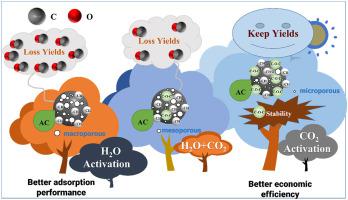Biomass & Bioenergy ( IF 5.8 ) Pub Date : 2023-05-07 , DOI: 10.1016/j.biombioe.2023.106811 Cong Ming , Yuchen Jiang , Chao Li , Qifeng Chen , Shu Zhang , Shuang Wang , Bin Li , Zhenhua Cui , Yonggui Tang , Xun Hu

|
CO2 and H2O are two important activators in production of activated carbon (AC) via physical activation method. They could oxidize the carbonaceous species in biochar or biomass via varied mechanisms and might also impact environments as well as the pore structures and evolution of functionalities of AC in different ways. In this study, the activations of the biochar from pyrolysis of cellulose with H2O, CO2 or mixed H2O/CO2 were performed. The results demonstrated that H2O as an activator led to higher weight loss than that of CO2 during the activation, originating from its higher efficiency for oxidation of the aliphatic structures in biochar to –OH and their further removal via deoxygenation or dehydration. Activation with CO2 made the AC more oxygen-rich, due to the retainment of abundant oxygen-containing functionalities, which suppressed further oxidation of carbon species and led to formation of main micropores. The higher capability of H2O for deoxygenation made the AC more carbon-rich with much more developed pore structures as well as higher proportion of mesopores and thus the superior capability for adsorption of phenol. In addition, during the activation in either CO2 or H2O, the unsaturated aldehyde/ketone and C-O-C structures was thermally more stable than lactones, saturated aliphatic acids and aliphatic aldehydes. The life cycle analysis (LCA) suggested that CO2 activation showed lower impact on environment by reducing emissions and consumption of fossil fuel.
中文翻译:

用 CO2 和/或 H2O 激活纤维素:生物炭功能的演变和环境影响
CO 2和H 2 O是物理活化法生产活性炭(AC)中的两种重要活化剂。它们可以通过不同的机制氧化生物炭或生物质中的含碳物质,也可能以不同的方式影响环境以及活性炭的孔结构和功能演变。在这项研究中,对纤维素与 H 2 O、CO 2或混合 H 2 O/CO 2热解产生的生物炭进行了活化。结果表明,H 2 O 作为活化剂在活化过程中导致比 CO 2更高的重量损失,这源于其更高的氧化效率将生物炭中的脂肪族结构转化为-OH,并通过脱氧或脱水进一步去除。由于保留了丰富的含氧官能团,因此用CO 2活化使活性炭更加富氧,这抑制了碳物种的进一步氧化并导致主要微孔的形成。H 2 O较高的脱氧能力使活性炭更富碳,孔结构更发达,中孔比例更高,因此吸附苯酚的能力更强。此外,在 CO 2或 H 2 O 中的活化过程中,不饱和醛/酮和 COC 结构比内酯更热稳定, 饱和脂肪酸和脂肪醛。生命周期分析 (LCA) 表明,CO 2活化通过减少化石燃料的排放和消耗,对环境的影响较小。











































 京公网安备 11010802027423号
京公网安备 11010802027423号